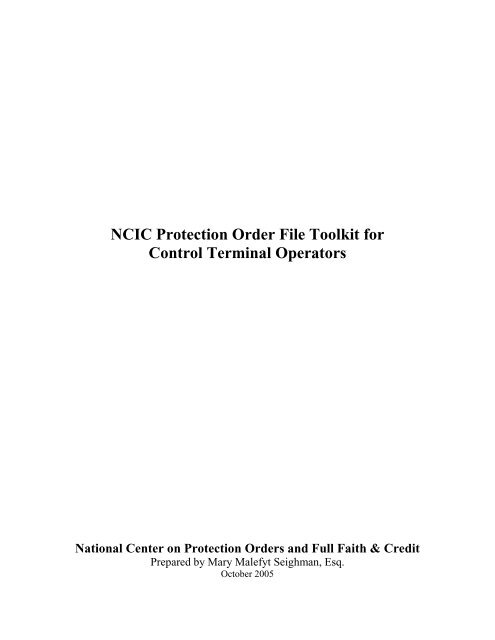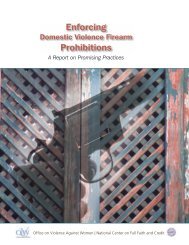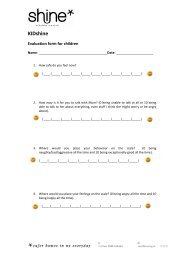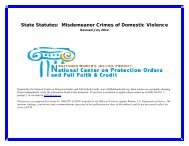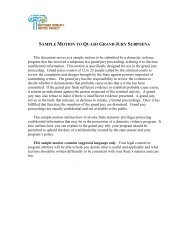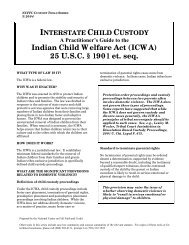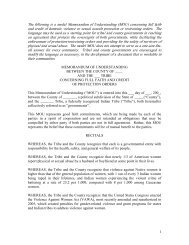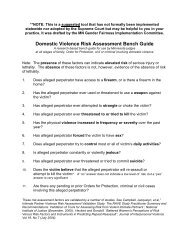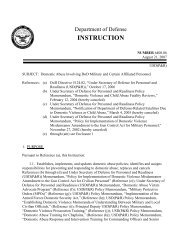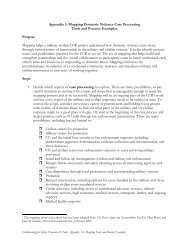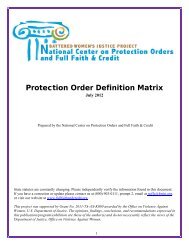NCIC Protection Order Toolkit for
NCIC Protection Order Toolkit for
NCIC Protection Order Toolkit for
You also want an ePaper? Increase the reach of your titles
YUMPU automatically turns print PDFs into web optimized ePapers that Google loves.
<strong>NCIC</strong> <strong>Protection</strong> <strong>Order</strong> File <strong>Toolkit</strong> <strong>for</strong><br />
Control Terminal Operators<br />
National Center on <strong>Protection</strong> <strong>Order</strong>s and Full Faith & Credit<br />
Prepared by Mary Malefyt Seighman, Esq.<br />
October 2005
<strong>NCIC</strong> <strong>Toolkit</strong> <strong>for</strong> Control Terminal Operators<br />
National Center on <strong>Protection</strong> <strong>Order</strong>s and Full Faith & Credit<br />
October 2005<br />
Table of Contents<br />
I. Introduction and Purpose .................................................................................................... 1<br />
II. <strong>Protection</strong> <strong>Order</strong>s Eligible <strong>for</strong> Entry into the <strong>NCIC</strong> POF ................................................... 2<br />
III. Entry of <strong>Order</strong>s ................................................................................................................... 3<br />
A. TIMELY ENTRY ......................................................................................................................................... 3<br />
B. MESSAGE KEY CODES .............................................................................................................................. 3<br />
C. ENTRY CRITERIA ...................................................................................................................................... 3<br />
D. PROTECTION ORDER CONDITIONS ............................................................................................................ 5<br />
E. BRADY INDICATOR ................................................................................................................................... 6<br />
F. MISCELLANEOUS FIELD ............................................................................................................................ 8<br />
IV. Modification of <strong>Order</strong>s and Supplemental Records............................................................ 9<br />
V. Retention of <strong>Protection</strong> <strong>Order</strong> Records ............................................................................... 9<br />
VI. Entering Agency Requirements <strong>for</strong> Handling a Hit .......................................................... 10
<strong>NCIC</strong> <strong>Toolkit</strong> <strong>for</strong> Control Terminal Operators<br />
National Center on <strong>Protection</strong> <strong>Order</strong>s and Full Faith & Credit<br />
October 2005<br />
I. Introduction and Purpose<br />
The National Crime In<strong>for</strong>mation Center <strong>Protection</strong> <strong>Order</strong> File (<strong>NCIC</strong> POF) was developed<br />
approximately ten years ago to serve as the national registry <strong>for</strong> protection orders issued in all<br />
fifty states. The <strong>NCIC</strong> POF is a voluntary system. While the <strong>NCIC</strong> POF currently contains<br />
protection orders from <strong>for</strong>ty-eight states and some of the 562 Indian tribes, not all of the current<br />
protection orders that are issued by the courts of the participating states and Indian tribes are<br />
contained in the <strong>NCIC</strong> POF. There are numerous reasons why this is the case, including data<br />
entry backlogs, voluntary or inconsistent entry by counties in the participating states, and<br />
protection orders that lack data that is required <strong>for</strong> successful entry.<br />
The <strong>NCIC</strong> POF is designed to facilitate the en<strong>for</strong>cement of protection orders and the Federal<br />
firearm laws. In terms of en<strong>for</strong>cement of protection orders, the presence of a protection order in<br />
the <strong>NCIC</strong> POF can be particularly critical when a protected party requests en<strong>for</strong>cement of an<br />
order outside of the jurisdiction in which the order was issued and he/she does not have a paper<br />
copy of the protection order on her person. The <strong>NCIC</strong> POF is one of the files that is searched<br />
when a background check is requested of the National Instant Criminal Background Check<br />
System (NICS) prior to the transfer of a firearm to a potential firearm buyer. However, the<br />
system is currently incomplete and does not contain all valid and en<strong>for</strong>ceable protection orders.<br />
Whether a protection order is contained in the <strong>NCIC</strong> POF has no bearing on its existence and<br />
en<strong>for</strong>ceability; however, a registry that contains all current protection orders would better<br />
facilitate the en<strong>for</strong>cement of protection orders when no other evidence of an existing protection<br />
order is available at the time en<strong>for</strong>cement is sought. Additionally, it would make it more likely<br />
that the NICS system will be able to verify that a potential firearm buyer is prohibited from<br />
purchasing a firearm pursuant to Federal law, particularly when the buyer attempts to purchase a<br />
firearm in a jurisdiction other than the one in which the protection order was issued.<br />
This toolkit was created to assist agencies that are responsible <strong>for</strong> entering protection orders into<br />
the <strong>NCIC</strong> POF by providing data entry guidance and tips. It is not intended to serve as a<br />
substitute or replacement <strong>for</strong> the <strong>NCIC</strong> 2000 Operating Manual <strong>for</strong> the <strong>Protection</strong> <strong>Order</strong> File, or<br />
any other written document, training, or technical assistance produced or provided by the<br />
National Crime In<strong>for</strong>mation Center. The toolkit highlights areas of critical importance related to<br />
the entry of protection orders into the <strong>NCIC</strong> POF because of the impact that entry can have on<br />
victim, law en<strong>for</strong>cement, and community safety. It is hoped that the toolkit will facilitate the<br />
entry of a greater number of en<strong>for</strong>ceable protection orders in each jurisdiction, with the goal of<br />
achieving successful entry into the <strong>NCIC</strong> POF of all eligible protection orders within 24 hours<br />
after issuance by a court. For additional assistance or questions about protection orders and/or<br />
firearms, contact the National Center on <strong>Protection</strong> <strong>Order</strong>s and Full Faith & Credit at (800) 903-<br />
0111, prompt 2 or (703) 312-7922.
II.<br />
<strong>Protection</strong> <strong>Order</strong>s Eligible <strong>for</strong> Entry into the <strong>NCIC</strong> POF<br />
All records entered into the <strong>NCIC</strong> POF must be supported by a protection order that meets the<br />
following definition:<br />
Additionally, the Respondent to<br />
the protection order must be<br />
given reasonable notice and an<br />
opportunity to be heard<br />
sufficient to protect his/her<br />
right to due process. In the case<br />
of temporary or ex parte orders<br />
(orders that are issued prior to<br />
the Respondent being provided<br />
with notice and an opportunity<br />
The protection order (including any injunction or<br />
other order) must have been issued <strong>for</strong> the purpose<br />
of preventing violent or threatening acts or<br />
harassment against, or contact or communication<br />
with, or physical proximity to another person. This<br />
includes temporary and final orders issued by civil<br />
or criminal courts (other than support or child<br />
custody orders issued pursuant to state divorce and<br />
child custody laws, except to the extent that such<br />
orders are entitled to full faith and credit under<br />
other federal laws) whether obtained by filing an<br />
independent action or as a pendente lite 1 order in<br />
another proceeding so long as any civil order was<br />
issued in response to a complaint, petition, or<br />
motion filed by or o behalf of a person seeking<br />
protection. 2<br />
TIP – TEMPORARY / EX PARTE PROTECTION ORDERS<br />
A hearing need not have been held be<strong>for</strong>e a temporary/ex parte<br />
protection order can be entered into the <strong>NCIC</strong> POF. If the order<br />
has not yet been achieved by the time that the order is entered into<br />
the POF, a note can be made in the Miscellaneous (MIS) field.<br />
Once the order has been served, the record should reflect this by<br />
modifying the order and entering a note to this effect in the MIS<br />
field.<br />
to be heard on the matter), notice and an opportunity to be heard must be provided within the<br />
time required by state or tribal law, or, in any event, within a reasonable period of time.<br />
This definition of protection orders is extremely broad, making most protection orders issued by<br />
courts eligible <strong>for</strong> entry into the <strong>NCIC</strong> POF. Additionally, note the following:<br />
♦ There is no particular relationship required between the Petitioner and the Respondent;<br />
♦ The purpose <strong>for</strong> which the order is issued is not limited to the prevention of acts of<br />
domestic violence, only that it must be issued to prevent violence, threats, and harassment<br />
against; contact, communication, contact with; or proximity to the protected person(s);<br />
♦ Temporary/ex parte protection orders can be entered into the system, as well as final<br />
orders;<br />
1 A pendente lite order is one that is issued during a proceeding or litigation. See Black’s Law Dictionary, 7 th Ed.<br />
2 <strong>NCIC</strong> 2000 Operating Manual, <strong>Protection</strong> <strong>Order</strong> File (October 12, 2005).<br />
<strong>NCIC</strong> <strong>Toolkit</strong><br />
National Center on <strong>Protection</strong> <strong>Order</strong>s and Full Faith & Credit<br />
October 2005<br />
2
♦ <strong>Order</strong>s issued by criminal courts may be entered, including bail/bond conditions,<br />
probation conditions, or parole conditions, provided they are issued <strong>for</strong> at least one of the<br />
purposes described above.<br />
III.<br />
Entry of <strong>Order</strong>s<br />
A. Timely Entry<br />
<strong>Order</strong>s issued by state courts should be entered into the <strong>NCIC</strong> POF and the State protection order<br />
registry within 24 hours after issuance by the court (or sooner, if required by State law or agency<br />
policy/procedures). Tribes that enter their orders directly into the <strong>NCIC</strong> POF should also ensure<br />
that they enter protection orders into the <strong>NCIC</strong> POF within 24 hours after issuance by the tribal<br />
court. State jurisdictions that have executed agreements or memoranda of understanding<br />
(MOUs) with a tribal jurisdiction to enter tribal orders into the <strong>NCIC</strong> POF should enter tribal<br />
orders into the <strong>NCIC</strong> POF within 24 hours of receipt at the entering agency specified in the<br />
agreement or MOU. Delays in the entry of protection orders into the system present risks to the<br />
Petitioner and other protected parties.<br />
B. Message Key Codes<br />
All protection orders entered into the <strong>NCIC</strong> POF must be<br />
assigned a message key code (MKE). A new order may be<br />
entered as either EPO (final protection order) or ETO (ex<br />
parte/temporary protection order).<br />
<strong>Protection</strong> orders issued against subjects who are believed to<br />
be armed and/or dangerous should be entered using a caution<br />
indicator. The MKE <strong>for</strong> these orders is slightly different:<br />
TIP – CHANGING ETO TO<br />
EPO<br />
If a temporary protection order<br />
record has been entered, it can<br />
later be modified (MKE/MTO)<br />
to a final protection order by<br />
changing the MKE from ETO<br />
to EPO.<br />
♦ EPOC (final protection order – caution)<br />
♦ ETOC (ex parte/temporary protection order – caution)<br />
TIP – CAUTION INDICATORS<br />
C. Entry Criteria<br />
If you enter the message key EPOC or ETOC, you<br />
must also indicate the reason <strong>for</strong> the caution in<br />
either the Miscellaneous (MIS) field or the<br />
Caution/Medical Condition field. The reason <strong>for</strong><br />
the caution should be entered as the first item in<br />
the MIS field.<br />
There are over 40 fields into which data may<br />
be entered <strong>for</strong> each protection order. Many of<br />
these are optional fields, or are conditional<br />
(i.e., required <strong>for</strong> entry only if data have been<br />
entered into another specified field). There are<br />
a number of mandatory fields <strong>for</strong> each POF<br />
record. The mandatory fields must contain<br />
data in order <strong>for</strong> a protection order to be successfully entered into the system.<br />
Table 1 contains the required fields and their codes, the minimum and maximum number of<br />
characters that may be used in each field, and the data type that is allowable. 3<br />
3 Refer to the <strong>NCIC</strong> 2000 CODE MANUAL <strong>for</strong> the allowable data type <strong>for</strong> two of the listed fields.<br />
<strong>NCIC</strong> <strong>Toolkit</strong><br />
National Center on <strong>Protection</strong> <strong>Order</strong>s and Full Faith & Credit<br />
October 2005<br />
3
Table 1: Required Fields<br />
Field Name<br />
Message<br />
Field Code<br />
Field Length<br />
(characters) Data Type<br />
Message Key MKE 3-4 Alphabetic<br />
Originating<br />
ORI 9-9 Alphabetic<br />
Agency Identifier<br />
Name<br />
(Respondent)<br />
NAM 3-30 Alphabetic,<br />
Numeric, Special<br />
Characters<br />
Sex (Respondent) SEX 1-1 Code as Defined in<br />
<strong>NCIC</strong> 2000 CODE<br />
MANUAL<br />
Race (Respondent) RAC 1-1 Code as Defined in<br />
<strong>NCIC</strong> 2000 CODE<br />
MANUAL<br />
Date of Expiration EXP 6-6<br />
8-8<br />
Alphabetic,<br />
Numeric<br />
<strong>Protection</strong> <strong>Order</strong> PCO 2-2 Numeric<br />
Conditions<br />
Brady Indicator BRD 1-1 Alphabetic<br />
Date of Issue<br />
ISD 8-8 Numeric<br />
(<strong>Protection</strong> <strong>Order</strong>)<br />
Originating<br />
Agency Case<br />
Number<br />
OCA 1-9<br />
1-20 (<strong>NCIC</strong> 2000<br />
<strong>for</strong>mat only)<br />
Alphabetic,<br />
Numeric, Special<br />
Characters<br />
If the Protected Person’s Name (PPN) field contains data, either the Protected Person’s Date of<br />
Birth (PPB) or the Protected Person’s Social Security Number (PSN) must be entered. However,<br />
if only the Protected Person’s Name is known, and not the date of birth or Social Security<br />
Number, the PPN can be entered into the Miscellaneous (MIS) field.<br />
Additionally, all records must contain at least one numeric identifier <strong>for</strong> the Respondent. For<br />
some of the identifiers, there are additional, conditional fields that must be entered if one of those<br />
identifiers is used.<br />
Table 2 contains allowable numeric identifiers. Please refer to the <strong>NCIC</strong> 2000 Operating<br />
Manual – <strong>Protection</strong> <strong>Order</strong> File <strong>for</strong> the message field code, field length, and data type <strong>for</strong> the<br />
conditional fields listed in Table 2.<br />
TIP – DATE OF EXPIRATION<br />
For the Date of Expiration field, if the protection order<br />
does not have an expiration date (i.e., it is a nonexpiring<br />
order or a lifetime order), NONEXP should be<br />
entered in the field.<br />
<strong>NCIC</strong> <strong>Toolkit</strong><br />
National Center on <strong>Protection</strong> <strong>Order</strong>s and Full Faith & Credit<br />
October 2005<br />
4
Table 2: Numeric Identifiers<br />
Field Name<br />
Message<br />
Field Code<br />
Field Length<br />
(characters) Data Type Conditional Fields<br />
Date of Birth DOB 8-8 Numeric None<br />
Social Security<br />
SOC 9-9 Numeric None<br />
Number<br />
License Plate<br />
Number<br />
LIC 1-8<br />
1-10 (<strong>NCIC</strong> 2000<br />
Alphabetic, Numeric License Plate State<br />
and License Plate<br />
Vehicle<br />
Identification<br />
Number<br />
Operator’s<br />
(Driver’s) License<br />
Number<br />
License Plate<br />
Number<br />
<strong>for</strong>mat only)<br />
Year of Expiration<br />
VIN 1-20 Alphabetic, Numeric Vehicle Year,<br />
Vehicle Make, and<br />
Vehicle Style<br />
OLN 1-20 Alphabetic, Numeric Operator’s License<br />
State and Operator’s<br />
License Year of<br />
Expiration<br />
LIC 1-8<br />
1-10 (<strong>NCIC</strong> 2000<br />
<strong>for</strong>mat only)<br />
Alphabetic, Numeric<br />
FBI Number FBI 1-9 Alphabetic, Numeric None<br />
Miscellaneous<br />
MNU 4-15 Numeric, Special None<br />
Number<br />
Characters<br />
License Plate State<br />
and License Plate<br />
Year of Expiration<br />
TIP – LICENSE PLATE NUMBERS<br />
It is not advisable to use the Respondent’s<br />
License Plate Number as the only numeric<br />
identifier, unless the license plate is a nonexpiring<br />
one. Data in the License Plate<br />
Number, License Plate Year of Expiration,<br />
and the License Plate Type fields in a base<br />
protection order record or a supplemental<br />
record will be purged one year after the<br />
license plate expires. If the expired license<br />
plate is the only searchable numeric identifier<br />
in the POF record, the entire protection order<br />
record will be purged from the system.<br />
A non-expiring license plate (LIY/NX)<br />
contained in a POF record will remain on file<br />
until action is taken by the originating agency<br />
to remove the license data or clear or cancel<br />
the entire protection order record, or when the<br />
protection order expires.<br />
<strong>NCIC</strong> <strong>Toolkit</strong><br />
National Center on <strong>Protection</strong> <strong>Order</strong>s and Full Faith & Credit<br />
October 2005<br />
D.<br />
Pro<br />
tect<br />
ion<br />
Or<br />
der<br />
Co<br />
ndi<br />
tio<br />
ns<br />
Th<br />
e<br />
text<br />
of<br />
a<br />
pro<br />
tect<br />
ion<br />
order condition may not be entered into the<br />
<strong>Protection</strong> <strong>Order</strong> Conditions (PCO) field.<br />
Rather, <strong>NCIC</strong> has assigned numbers to each of<br />
the most common types of conditions that may<br />
be contained in a protection order. The <strong>NCIC</strong><br />
TIP – PETITIONER’S VS.<br />
RESPONDENT’S NUMERIC<br />
IDENTIFIER<br />
While a protection order may now be entered<br />
into the <strong>NCIC</strong> POF if it contains a Protected<br />
Person’s Date of Birth or Protected Person’s<br />
Social Security Number, it is not advisable to<br />
enter an order into the system without also<br />
including one of the allowable numeric<br />
identifiers <strong>for</strong> the Respondent. Records<br />
containing only the protected person’s<br />
in<strong>for</strong>mation as the numeric identifier will not<br />
be hit upon when the inquiry is conducted on<br />
the Respondent to the protection order using<br />
the Respondent’s name and numeric<br />
identifier. Thus, if an inquiry of the <strong>NCIC</strong><br />
POF is conducted as a means to verify the<br />
existence of a protection order <strong>for</strong><br />
en<strong>for</strong>cement purposes, a protection order<br />
would most likely not be found in the<br />
system. Additionally, because many<br />
protection orders also disqualify<br />
Respondents from possessing, purchasing, or<br />
receiving a firearm <strong>for</strong> the duration of the<br />
protection order, a firearm background check<br />
conducted by NICS would most likely not<br />
discover a protection order that was entered<br />
without a numeric identifier <strong>for</strong> the<br />
Respondent, and the firearm could then be<br />
transferred to the Respondent.<br />
5
PCO Codes and their text translations are contained in Table 3.<br />
Table 3: <strong>Protection</strong> <strong>Order</strong> Conditions<br />
The subject is restrained from assaulting, threatening, abusing, harassing, following, interfering with,<br />
01 or stalking the protected person and/or the child of the protected person.<br />
02 The subject may not threaten a member of the protected person’s family or house-hold.<br />
03 The protected person is granted exclusive possession of the residence or household.<br />
04 The subject is required to stay away from the residence, property, school, or place of employment of<br />
the protected person or other family or household member.<br />
05 The subject is restrained from making any communication with the protected person, including but<br />
not limited to, personal, written or telephone contact, or their employers, employees, fellow workers,<br />
or others with whom the communication would be likely to cause annoyance or alarm the victim.<br />
06 The subject has visitation or custody rights of the child(ren) named.<br />
07 The subject is prohibited from possessing and/or purchasing a firearm or other weapon.<br />
08 See the Miscellaneous Field <strong>for</strong> comments regarding the terms and conditions of the order.<br />
09 The protected person is awarded temporary exclusive custody of the child(ren) named.<br />
The <strong>NCIC</strong> protection order conditions may be different from the conditions that are available<br />
pursuant to the state or tribal protection order code. It is advised that a uni<strong>for</strong>m conversion chart<br />
be developed that translates the state or tribal protection order conditions specified in the<br />
state/tribal protection order statute to the proper <strong>NCIC</strong> PCO<br />
code. The conversion chart should be developed in<br />
conjunction with courts, prosecutors, and domestic violence<br />
advocates, and distributed statewide to all agencies that enter<br />
protection orders into the <strong>NCIC</strong> POF.<br />
The following is an example of how such a conversion chart<br />
might appear:<br />
If State Condition: Enter <strong>NCIC</strong> POF Code:<br />
1 01 and 02<br />
2 03<br />
3 06 and 09 (specific terms<br />
must be entered into the<br />
Miscellaneous Field)<br />
E. Brady Indicator<br />
TIP – CODES 06 AND 09 FOR<br />
VISITATION & CUSTODY<br />
Note that PCO 06 should only be<br />
entered if the Respondent to the<br />
protection order was awarded visitation<br />
and/or or custody of the child(ren)<br />
named in the protection order. If the<br />
Respondent has visitation rights<br />
pursuant to the protection order, but not<br />
custody, a note should be made in the<br />
Miscellaneous Field that the<br />
Respondent is allowed visitation, but<br />
does not have custody of the child(ren).<br />
If the Petitioner was awarded sole<br />
custody of the child(ren), condition 09<br />
should be entered.<br />
<strong>Protection</strong> orders that meet the conditions of 18 U.S.C. § 922(g)(8) prohibit a person from<br />
possessing, purchasing, or receiving a firearm or ammunition under Federal law.<br />
<strong>Order</strong>s that meet the requirements of this Federal statute must be entered as ‘Y’ in the Brady<br />
Indicator (BRD) field. The protection order <strong>for</strong>ms that are used in your jurisdiction may include<br />
a check box or other indicator that the conditions have been met to disqualify the Respondent<br />
from possessing, purchasing, or receiving a firearm or ammunition under Federal law. If the<br />
<strong>for</strong>m does not provide this in<strong>for</strong>mation, you will have to per<strong>for</strong>m an analysis regarding whether<br />
you should enter ‘Y’ or ‘N’ in the Brady Indicator field. Every attempt should be made to make<br />
<strong>NCIC</strong> <strong>Toolkit</strong><br />
National Center on <strong>Protection</strong> <strong>Order</strong>s and Full Faith & Credit<br />
October 2005<br />
6
the correct determination. A ‘U’ (Unknown) should only be used when it is impossible to make<br />
a determination. 4<br />
If nothing is entered into the BRD field, it will default to ‘N.” If the field incorrectly contains<br />
‘N’ when the Respondent is disqualified under the Federal law, a background check may not<br />
discover that the Respondent is disqualified, and the Respondent may be able to purchase a<br />
firearm. Possession of a firearm by a Respondent to a protection order can be extremely<br />
dangerous to the Petitioner, other protected parties and household members, law en<strong>for</strong>cement<br />
officers, and the entire community. The entering agency should consider the liability that may<br />
attach when an ‘N’ is entered incorrectly into the BRD field where the Respondent subsequently<br />
acquires a firearm through a federally licensed firearms dealer and the Respondent uses the<br />
firearm to injure or kill the Petitioner, the Petitioner’s children, a law en<strong>for</strong>cement officer, or<br />
someone else in the community.<br />
A protection order record requires entry of ‘Y’ in the Brady indicator field if the following<br />
conditions are met:<br />
(1) Type of <strong>Order</strong>. The order was issued after a hearing, of which the Respondent received<br />
notice and had an opportunity to participate.<br />
TIP – TYPE OF ORDER<br />
The order must be a final protection order, and may not be an ex parte protection order. The<br />
final order may be an agreed order, consent order, or default order, as long as the order was<br />
issued or agreed to by the parties after the Respondent was provided with notice that the<br />
Petitioner filed a petition <strong>for</strong> a protection order, and the Respondent had an opportunity to<br />
appear at a hearing. The Respondent need not have appeared at the hearing in order to enter ‘Y’<br />
in the Brady indicator field. The hearing need not have been a hearing at which evidence was<br />
proffered or testimony provided.<br />
(2) Intimate Partner Relationship. The Petitioner has an ‘intimate partner’ relationship to the<br />
Respondent that can be described as one of the following:<br />
♦<br />
♦<br />
♦<br />
♦<br />
Spouse or <strong>for</strong>mer spouse;<br />
Cohabit or have cohabited with respondent;<br />
Have a child in common; OR<br />
The Petitioner is a child of the Respondent or the intimate partner.<br />
TIP – INTIMATE PARTNER<br />
(2) Intimate Partner. If your state’s or tribe’s protection order statute has relationship eligibility<br />
requirements that are the same as, or more narrow than, the Federal definition of ‘intimate<br />
partner,’ the order will automatically meet this element of the Federal statute. If your state or<br />
tribal statute is broader, you will have to determine the relationship of the Petitioner to the<br />
Respondent, and whether it meets the requirements of the Federal statute. If the Petitioner had a<br />
dating relationship with the Respondent, but they never lived together or had a child together,<br />
the order will not qualify under the Federal statute, and you should enter ‘N’ in the Brady<br />
Indicator field.<br />
4 <strong>NCIC</strong> 2000 Operating Manual, <strong>Protection</strong> <strong>Order</strong> File (October 12, 2005).<br />
<strong>NCIC</strong> <strong>Toolkit</strong><br />
National Center on <strong>Protection</strong> <strong>Order</strong>s and Full Faith & Credit<br />
October 2005<br />
7
(3) Purpose of the <strong>Order</strong>. The order restrains the Respondent from harassing, stalking, or<br />
threatening an intimate partner, or the partner’s child, or engaging in other conduct that<br />
would place an intimate partner in reasonable fear of bodily injury to him/herself or the<br />
child.<br />
TIP – PURPOSE OF ORDER<br />
Most protection orders issued pursuant to the state or tribal protection order statute will meet<br />
this requirement. A protection order meets the requirement provided the statutory authority <strong>for</strong><br />
issuing the order specifies that protection orders issued pursuant to the statute are intended to<br />
prevent future abuse, violence, injury, harassment, etc.<br />
(4) Credible Threat Finding or Terms of the <strong>Order</strong>. The order includes a finding that the<br />
Respondent represents a credible threat to the physical safety of the Petitioner or the child<br />
OR<br />
The terms of the order prohibit the use, attempted use or threatened use of physical <strong>for</strong>ce<br />
against the Petitioner or the child that would reasonably be expected to cause bodily<br />
injury.<br />
If the requirements <strong>for</strong> the Federal statute are met, ‘Y’ should be entered in the BRD field. A<br />
caveat will be generated as part of a response to an <strong>NCIC</strong> 2000 query. The language of the<br />
caveat will appear as follows:<br />
****THE SUBJECT OF THIS RECORD IS PROHIBITED FROM RECEIVING OR<br />
POSSESSING A FIREARM UNDER FEDERAL LAW (TITLE 18, U.S.C. SECTION 922)****<br />
F. Miscellaneous Field<br />
TIP – CREDIBLE THREAT OR TERMS OF PROTECTION ORDER<br />
There need not be a credible threat finding by the court that issued the order. In most cases, this<br />
requirement (credible threat finding or terms of the order) is satisfied by the inclusion of at least<br />
one provision that is equivalent to a prohibition on the use, attempted use, or threatened use of<br />
physical <strong>for</strong>ce against the Petitioner or a child. Depending on the definition of terms that are used<br />
in the state or tribal protection order statute, relief that prohibits abuse, assault, or threats of<br />
violence should be sufficient <strong>for</strong> purposes of this requirement.<br />
The Miscellaneous field (MIS) should be used to provide more specific in<strong>for</strong>mation about the<br />
terms of the protection order. For example, if PCO 04 is entered, the MIS field should provide<br />
more in<strong>for</strong>mation about the places from which the Respondent is prohibited from going, and/or<br />
any exceptions to the prohibition. For example, “PCO 04 STAY AWAY FROM ALL<br />
LOCATIONS PPN IS KNOWN TO BE EXCEPT HOME OF PPN WHEN PICKING UP AND<br />
DROPPING OFF CHILDREN FOR VISITATION ON WEDNESDAY EVENING AND<br />
ALTERNATING FRIDAYS/SUNDAYS.”<br />
<strong>NCIC</strong> <strong>Toolkit</strong><br />
National Center on <strong>Protection</strong> <strong>Order</strong>s and Full Faith & Credit<br />
October 2005<br />
8
The MIS field can also be used to provide details about service of the order (i.e., whether service<br />
has been effected, or whether the order has not yet been served on the Respondent). This can be<br />
extremely useful to law en<strong>for</strong>cement officers (particularly if they are not in the jurisdiction in<br />
which the order was issued) who need to determine whether a Respondent has been provided<br />
with notice of the issuance of a temporary/ex parte protection order be<strong>for</strong>e they en<strong>for</strong>ce the<br />
order.<br />
IV.<br />
Modification of <strong>Order</strong>s and Supplemental Records<br />
A protection order record may be modified, but only by the agency that entered the record. A<br />
modification message is used to add to, delete, or change data in the base record. The following<br />
are points to remember regarding modification of orders:<br />
♦<br />
♦<br />
♦<br />
♦<br />
♦<br />
If an agency has entered a temporary protection order record, it can be modified to a<br />
final protection order record by changing the MKE from ETO to EPO.<br />
If the court that issued the protection order<br />
modifies it in any way, the court must notify the<br />
agency that entered the order into the <strong>NCIC</strong> POF.<br />
If a court modifies the expiration date of a<br />
protection order, but the order has already expired<br />
be<strong>for</strong>e the modification can be entered into the<br />
<strong>NCIC</strong> POF, the entire record must be re-entered.<br />
TIP – COMMUNICATIONS<br />
REGARDING<br />
MODIFICATIONS<br />
Entering agencies should<br />
collaborate with the courts that<br />
issue protection orders to develop<br />
or enhance communication systems<br />
<strong>for</strong> providing notification of<br />
modifications or dismissals of<br />
protection orders.<br />
The entering agency will receive a message five<br />
days prior to the expiration of a protection order to<br />
remind the agency to enter any modifications to the expiration date if the protection<br />
order was extended or renewed by the court.<br />
Records that have been cleared or expired and are in an inactive status cannot be<br />
modified.<br />
A supplemental record should be entered in order to provide additional identifiers to an existing<br />
protection order record. For example, if the entering agency receives the license plate number<br />
<strong>for</strong> the Respondent, and entry of that number has been requested, the entering agency would add<br />
a supplemental record with the license plate number to the existing record. See the <strong>NCIC</strong> 2000<br />
Operating Manual – <strong>Protection</strong> <strong>Order</strong> File <strong>for</strong> details on the data fields that may be included in a<br />
supplemental record, along with their field codes and the maximum number allowable in a POF<br />
record.<br />
V. Retention of <strong>Protection</strong> <strong>Order</strong> Records<br />
A protection order record remains active in the <strong>NCIC</strong> POF until it is cancelled or cleared by the<br />
entering agency, or until the order expires. Five days be<strong>for</strong>e a protection order’s expiration date,<br />
<strong>NCIC</strong> sends the entering agency an administrative message as a reminder to enter a modified<br />
expiration date should the court extend or renew the order. If the expiration date is not modified<br />
within the five-day period, the record expires and becomes inactive after the fifth day. Inactive<br />
<strong>NCIC</strong> <strong>Toolkit</strong><br />
National Center on <strong>Protection</strong> <strong>Order</strong>s and Full Faith & Credit<br />
October 2005<br />
9
ecords (those that have been cleared and those that have expired) will be maintained online <strong>for</strong><br />
the remainder of the current year, plus an additional five years, and are accessible via the QPO<br />
message <strong>for</strong> this period of time. At the end of the five-year period, <strong>NCIC</strong> sends an<br />
administrative message to the entering agency to provide notification that the record will be<br />
retired because it has reached the end of the retention period.<br />
Records <strong>for</strong> non-expiring protection orders (i.e., those <strong>for</strong> which there is no expiration date)<br />
remain active in the <strong>NCIC</strong> POF until they have been cleared or cancelled by the entering agency.<br />
VI.<br />
Entering Agency Requirements <strong>for</strong> Handling a Hit<br />
When a hit on a protection order record is obtained, the entering agency must be able to confirm<br />
the status and terms of a protection order to the querying agency. The entering agency must<br />
either have the ability to provide this service 24 hours a day, 7 days a week, or must obtain the<br />
written agreement of another agency that it will provide responses to hit confirmation requests.<br />
For more in<strong>for</strong>mation on this toolkit, protection orders, and/or firearms, contact the<br />
National Center on <strong>Protection</strong> <strong>Order</strong>s and Full Faith & Credit at (800) 903-0111, prompt 2<br />
or (703) 312-7922.<br />
<strong>NCIC</strong> <strong>Toolkit</strong><br />
National Center on <strong>Protection</strong> <strong>Order</strong>s and Full Faith & Credit<br />
October 2005<br />
10


